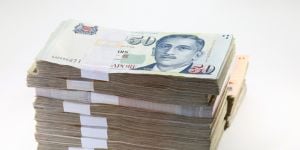It’s 930 Monday morning and there are two little boys standing in my living room.
The boys and their 2 yr old sister, Crystal, live in our condominium, Emerald Gardens, here in Chinatown. The pagoda inspired complex is comprised of four, 12-story buildings, with two, three, and four bedroom apartments of varying size. The buildings are clustered around a courtyard with a decent sized pool and quaint little waterfall. There are half a dozen teak lounge chairs--always staked out early on the weekends'and a bbq pit you can rent for a $100 deposit. Our two-bedroom apartment faces the courtyard, so during the day we hear the faint whisper of the waterfall, and on the weekends, the 'mates' throwing shrimp on the barbie.
The complex is primarily home to people from England, Oz, New Zealand, Canada, America, and various European countries. There are a few locals here and there'¦Dylan, Jake and Crystal's mom is Singaporean, for example, although their father is an Aussie. Emerald Gardens is situated on Club Street'¦ originally named for the Chinese mahjong clubs it hosted. (Think 'moose' lodge for Chinese businessmen circa 1880's). The historic 'shop houses' that line the little avenue have since been turned into bars, pubs and French restaurants patronized mainly by 'yuppies and expats', as Wikipedia puts it. While looking for a place to live, we had three major requirements: a short commute for my husband, an active and central location, and a pool. This place fit the bill, despite the expat 'bubble' factor. On the plus side, when you jump in a cab and tell the driver you live in Chinatown, he knows the address immediately. Emerald Gardens is the only ang-moh place in the neighborhood.
Ah yes, ang-mohs. Literally meaning 'red hair''¦ or 'red haired devil'. It's a term of endearment, or repulsion, that the locals use to mean Caucasian. (P.S. moving here from Washington DC where I was a 'white girl', I've learned that 'Caucasian' is the more common way to call someone who is well, white). Depending on who you ask, the term ang-moh is either a way to poke fun at Caucasian foreigners, or it's right up there with the 'N' word.As is true with most euphemisms, there is historical significance behind the negativity of the word. A brief look back explains this and some of the remaining animosity towards Caucasians. Here's the (very) abridged version: the British colonized Singapore in the early 1800's from the Chinese, and Malays who inhabited the island. During WWII, the Japanese took control from the British and severely tortured and humiliated the local population. Once the war was over, the Brits came back-- leaving the Chinese, Malays and Indians feeling frustrated and angered at the red haired sailors who once again took control of their island.Thus they adapted a word to describe the round-eyed-light-skinned visitors that kept seizing their land.
Consider the current situation here in Singapore: about 75% of the population is Chinese, 13% Malay, 8% Indian, and Caucasians are included in the category of 'others' making up less than 3%. However everyone is required to speak and read English. Advertisements often show Caucasian folks instead of Chinese'¦ Western culture and brands are everywhere. Walk through the shopping district of Singapore you'll find a Gucci and a Starbucks on every corner. You can get McDonald's delivered to your doorstep for crying out loud.
Understandably, Singaporean blogs and on-line chat rooms serve as a place for the locals to vent about this ever looming 'ang moh' presence. A Singaporean journalist wonders about the reasons for her lingering prejudices:Yet why is it that I don't feel as comfortable with Caucasians as I do with, say, Indians or Indonesians? Is it the language?... Is it '¦because I don't meet the blonde-hair, blue-eyes ideal, [so] I don't feel attractive enough in their presence? '¦.Or could I actually be harbouring lingering anti-colonial resentment?
(Sumiko Tan, Brunei Times, May 10 2007)
Growing up a white, American Gen-Xer, I learned about racism through stories about the Middle Passage, Rosa Parks and MLK. To this day, I am, along with most of my white American friends whether they admit it or not, harboring some kind of white guilt. But dealing with white guilt in a country where 'white' is the majority was one thing'¦ here in Singapore, I still carry around the guilt, it just seems a lot heavier as the priviledged minority.
So that's where the work comes in'on my part'to help dispel the myth about Caucasians. You could say I've kind of made it my mission. Do I get stared at? Yes. Are there dirty looks? Sometimes. Does it make me feel bad? Not really. When I'm being inspected, I look folks in the eye and flash a big smile. Usually, they smile back and go about their business. But sometimes they don't. Recently while taking the bus, an older gentleman had me in eye-lock for several moments. I did my usual 'smile and hi' routine. He didn't budge. I said hi again, and asked him how he was doing today. He nodded his head and mumbled something, and kept the stare. I asked him if he was from Singapore. Again, he nodded and mustered a 'yes'. After a few minutes, we both got off at the same stop. I could feel him starting to warm up to me. He walked with me for several blocks, each of us asking the other some general questions. 'Where you from?' America. 'What you do?' Journalist. 'Where you live?' Club Street-- and we went on like this for at least 10 minutes. It was nice somehow'¦ for me at least, and hopefully for him as well.
Despite any underlying intolerance (and its not just towards Caucasian-- the Chinese and Malays have their own history of resentment towards each other) today, Singapore prides itself on its multi-nationalism. There are four official languages (English, Chinese, Malay, and Tamil) and the utmost in religious respect (on my street alone, there is a Methodist church, a Buddhist temple, a Hindu temple and a Muslim mosque'¦in that order, practically next door to each other). As stated by the government, racial and religious harmony are central to the success of the country as a whole. At the end of the day, it seems that people are at least making a concerted effort.As for me, well, I would go as far as to say that I have some Singaporean friends already.
Dylan, Jake and Crystal might not be pure Singaporean by blood, but they are the epitome of modern day Singaporeans. Like more and more children here, they are citizens of the world, and don't take notice of such things like skin color. For now they seem content with their new friend, Golfo'¦. A Spanish speaking dog from America. And I know the relationship is mutual.We do our best to provide accurate and up to date information. However, if you have noticed any inaccuracies in this article, please let us know in the comments section below.






